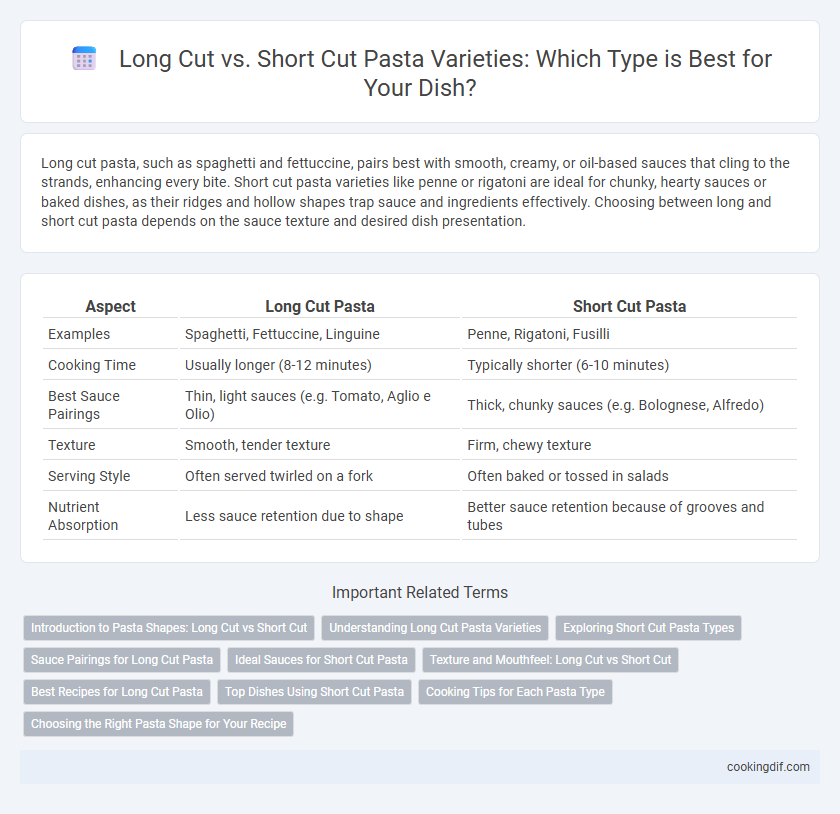Long cut pasta, such as spaghetti and fettuccine, pairs best with smooth, creamy, or oil-based sauces that cling to the strands, enhancing every bite. Short cut pasta varieties like penne or rigatoni are ideal for chunky, hearty sauces or baked dishes, as their ridges and hollow shapes trap sauce and ingredients effectively. Choosing between long and short cut pasta depends on the sauce texture and desired dish presentation.
Table of Comparison
| Aspect | Long Cut Pasta | Short Cut Pasta |
|---|---|---|
| Examples | Spaghetti, Fettuccine, Linguine | Penne, Rigatoni, Fusilli |
| Cooking Time | Usually longer (8-12 minutes) | Typically shorter (6-10 minutes) |
| Best Sauce Pairings | Thin, light sauces (e.g. Tomato, Aglio e Olio) | Thick, chunky sauces (e.g. Bolognese, Alfredo) |
| Texture | Smooth, tender texture | Firm, chewy texture |
| Serving Style | Often served twirled on a fork | Often baked or tossed in salads |
| Nutrient Absorption | Less sauce retention due to shape | Better sauce retention because of grooves and tubes |
Introduction to Pasta Shapes: Long Cut vs Short Cut
Long cut pasta varieties like spaghetti, fettuccine, and linguine excel in holding lighter, oil-based sauces and are ideal for twirling techniques. Short cut pasta such as penne, rigatoni, and farfalle provide a sturdy texture that traps chunky sauces and ingredients within their shapes. Choosing between long and short cut pasta enhances the dish's texture and flavor absorption, optimizing the culinary experience.
Understanding Long Cut Pasta Varieties
Long cut pasta varieties, such as spaghetti, linguine, and fettuccine, are characterized by their elongated shape, making them ideal for light, smooth sauces that cling to their surface. These pasta shapes excel in dishes where the texture and mouthfeel play a significant role, enhancing the overall eating experience. Understanding the unique qualities of long cut pasta helps in selecting the perfect pairing for seafood, cream-based, or olive oil-based sauces.
Exploring Short Cut Pasta Types
Short cut pasta varieties such as penne, fusilli, and farfalle are prized for their ability to hold sauces in their grooves and crevices, making them ideal for chunky or creamy sauces. These shapes cook faster than long cut pastas like spaghetti or fettuccine, offering convenience for quick meals while providing a textured bite that enhances flavor absorption. Their compact size allows versatility in salads, soups, and baked dishes, distinguishing them from the more traditional elongated pasta types.
Sauce Pairings for Long Cut Pasta
Long cut pasta varieties like spaghetti, fettuccine, and linguine excel with smooth, oil-based or creamy sauces that evenly coat each strand, such as marinara, Alfredo, or pesto. Their elongated shape allows the sauce to cling efficiently, enhancing flavor distribution and texture in every bite. Chunky or heavy meat sauces are better suited for short cut pasta, which can trap and hold robust ingredients more effectively.
Ideal Sauces for Short Cut Pasta
Short cut pasta varieties such as penne, fusilli, and rigatoni excel with chunky and hearty sauces that cling to their ridges and hollow shapes. These shapes are ideal for thick tomato-based sauces, creamy Alfredo, or meat ragu because they trap bits of vegetables, meat, and cheese. The texture and size of short cut pasta ensure an even distribution of sauce in every bite, enhancing flavor and mouthfeel.
Texture and Mouthfeel: Long Cut vs Short Cut
Long cut pasta varieties like spaghetti and fettuccine offer a smooth, continuous texture that enhances mouthfeel by allowing sauce to coat evenly along each strand, creating a balanced bite. Short cut pasta such as penne and rigatoni provides a firmer, more textured mouthfeel, with ridges and hollow shapes that trap chunky sauces and add a pleasing chewiness. Texture differences between long and short cut pastas significantly influence the overall sensory experience, pairing best with complementary sauce consistencies.
Best Recipes for Long Cut Pasta
Long cut pasta varieties like spaghetti, fettuccine, and linguine excel in recipes with smooth, creamy sauces, as their shape allows even coating and a delicate texture. Ideal dishes include classic Alfredo, carbonara, and seafood pasta where the strands can twirl easily, enhancing both flavor and presentation. These pasta types also pair well with light olive oil-based sauces infused with garlic and herbs, creating a balanced and elegant meal.
Top Dishes Using Short Cut Pasta
Short cut pasta varieties, such as penne, fusilli, and farfalle, excel in capturing sauces and are ideal for baked dishes, pasta salads, and casseroles. Top dishes using short cut pasta include classic baked ziti, creamy mac and cheese, and Italian pasta salad, where their shape enhances flavor absorption and texture. These pasta forms offer versatility, making them a staple in recipes that combine multiple ingredients and robust sauces.
Cooking Tips for Each Pasta Type
Long cut pasta varieties like spaghetti and fettuccine require ample boiling water and frequent stirring to prevent sticking and ensure even cooking. Short cut pasta types such as penne and fusilli benefit from shorter cooking times and occasional stirring to maintain their shape and texture. Adjust cooking times based on package instructions and taste tests for optimal al dente results in both pasta types.
Choosing the Right Pasta Shape for Your Recipe
Long cut pasta varieties like spaghetti and fettuccine excel at holding rich, creamy sauces due to their smooth, flat surfaces that wrap evenly around the sauce. Short cut shapes such as penne and rigatoni provide ideal texture and sauce retention for chunky or baked dishes because their ridges and hollow centers trap bits of sauce and ingredients. Selecting the right pasta shape enhances flavor absorption and mouthfeel, ensuring the dish's sauce-to-pasta ratio complements the intended culinary experience.
Long cut vs short cut for pasta varieties Infographic

 cookingdif.com
cookingdif.com